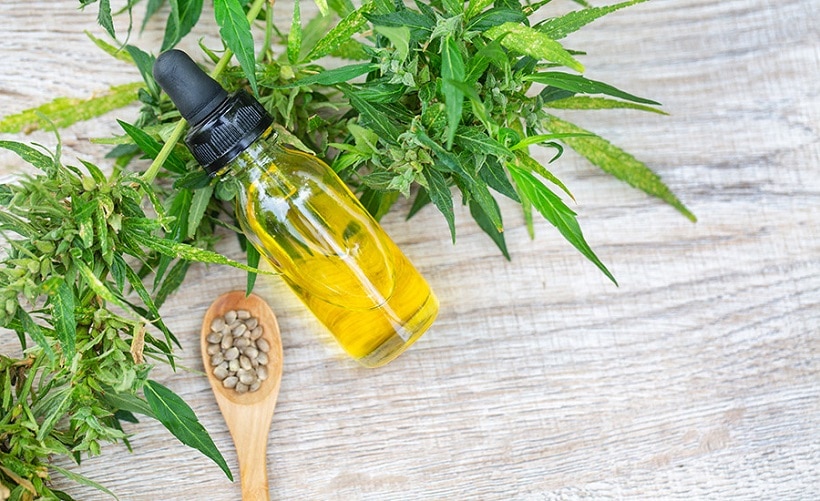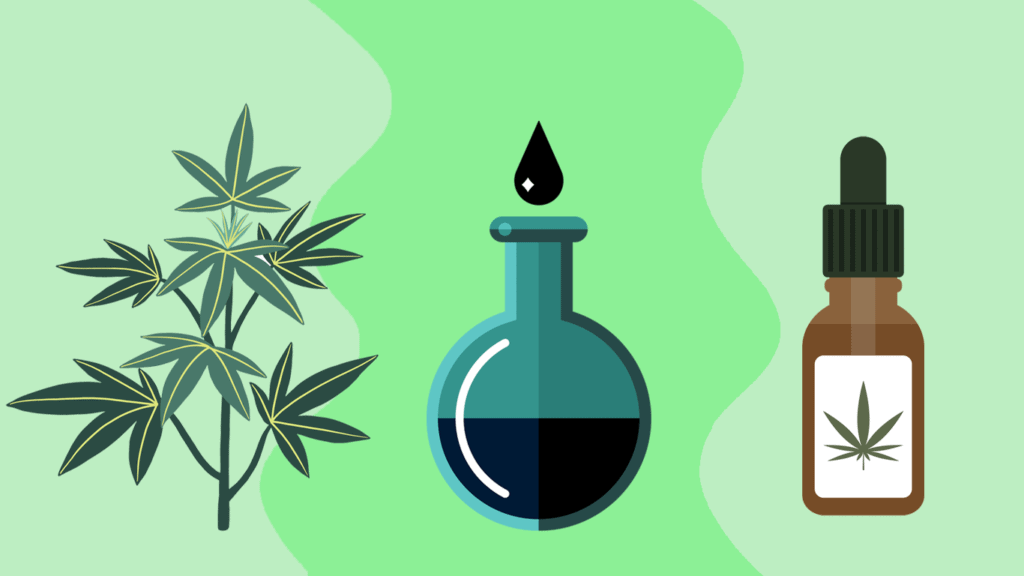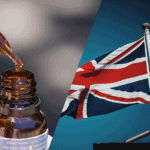Key takeaways:
- There are three main types of CBD extraction: carbon dioxide (CO2), ethanol, and lipid infusion. All three are considered safe and effective.
- CO2 extraction is the most popular and involves using pressurized carbon dioxide to pull CBD and other beneficial compounds out of hemp.
- Ethanol is another common method that involves soaking the hemp biomass in alcohol to separate the CBD and other beneficial compounds. The ethanol is then evaporated, leaving behind a crude extract.
- Lipid infusion involves soaking the hemp material in olive oil or another natural oil with heat and pressure. This method is the least intrusive but less efficient and more labor-intensive.
CBD extraction might sound overly scientific, but it’s really not that complex. The goal of any extraction method is to pull CBD and other beneficial compounds (cannabinoids, terpenes, flavonoids) out of the hemp plant material (usually the flowers).
The resulting extract can then be used to make CBD oils, capsules, topicals, edibles, vapes, and more. Although most CBD companies will claim that their extraction process is the best, the truth is that each CBD extraction method has its advantages and disadvantages.
In this article, we’ll explore the most common CBD extraction methods — CO2, ethanol, and lipid infusion — to help you understand how they work and their pros and cons.
Table of Contents
Carbon Dioxide (CO2) Extraction
Pros
- Highly tunable; can be used to extract specific compounds
- No risk for residual solvents because CO2 doesn’t need to be removed after extraction
- Less prone to destroying terpenes
- Eco-friendly
Cons
- Less efficient because parameters have to be changed for different types of extracts
- Requires greater training and higher upfront investment
Carbon dioxide (CO2) extraction uses carbon dioxide, the same chemical that we breathe daily. It’s the most popular method for extracting CBD. CO2 extraction is not a new process; it’s been widely used to decaffeinate coffee beans, extract spices, and remove nicotine from tobacco.
The main advantage of CO2 extraction is that it’s highly tunable, which means you can choose what to extract by changing the temperature and pressure (1). However, CO2 extraction equipment is costly and requires expertise.
There are two CO2 extraction methods: supercritical and subcritical. Both use pressurized carbon dioxide as a solvent, pulling CBD and other beneficial ingredients out of hemp plant material, after which the CO2 is depressurized and returns to its gas form.
CO2 extraction is considered a sustainable and eco-friendly option. The CO2 used during extraction can be recaptured each time for later use, doesn’t leave any harmful residue, and is completely non-toxic and renewable.

Supercritical CO2 Extraction
Supercritical CO2 extraction uses high pressures and temperatures to make carbon dioxide behave as both a gas and liquid simultaneously: what’s called a supercritical fluid. This makes it a very efficient solvent and is the most common way of performing CO2 extraction.
Subcritical CO2 Extraction
With subcritical CBD extraction, a lower temperature and pressure are used for the extraction process, meaning the CO2 remains in its liquid state.
This makes the extraction slower and less efficient but helps retain delicate compounds that are sensitive to high temperatures, such as terpenes.
Ethanol Extraction
Pros
- Extracts a broader variety of compounds from hemp
- Simpler process that requires less training and downtime
- Versatile; easy to accommodate different types of CBD products
- Eco-friendly
Cons
- Requires more post-processing to remove unwanted material like chlorophyll
- Many terpenes are destroyed when ethanol is evaporated post-extraction
Ethanol has been used for botanical extraction for thousands of years, especially for making herbal tinctures.
One of its main advantages is that ethanol is a polar solvent, which means it pulls out both fat-soluble (like cannabinoids and terpenes) and water-soluble (like some phenols and vitamins) compounds.
But this is a double-edged sword; you get more a broader range of beneficial compounds but also have to remove some unwanted ones, like chlorophyll.
Ethanol extraction can be done at cold or warm temperatures and is safe and efficient.
Cold Ethanol Extraction
The cold method involves soaking hemp in pre-chilled ethanol to separate the plant’s cannabinoid and terpene-containing trichomes effectively. The ethanol is then evaporated to leave behind the crude extract.
Warm Ethanol Extraction
Meanwhile, the warm method is more efficient (produces higher yields) but has the downside of pulling out undesirable compounds like fats and waxes, which require additional processing to remove. That’s why cold ethanol extraction is more popular.
The ethanol is evaporated after the extraction process, just like in the cold method.
Ethanol extraction is relatively simple, inexpensive, and suitable for both large and small-scale cannabis processors. It also does a great job of dissolving all of hemp’s compounds, including elusive flavonoids (2).
The main downside of ethanol extraction is the high boiling point. That means when ethanol evaporates from the solution, many of the fragile terpenes are also lost. That’s why companies that use ethanol extraction often separately add terpenes to their products.
Isopropyl Alcohol Extraction
Isopropyl alcohol (IPA) is a different type of alcohol that’s sometimes used for cannabis and CBD extraction.
This extraction method is similar to ethanol extraction. It uses the same idea: soak the hemp flowers in alcohol to extract the desirable compounds and then purge the alcohol.
Charlotte’s Web is one of the only CBD companies that continue to use this method but only for one product because it’s considered labor-intensive.

Lipid Infusion/Olive Oil Extraction
Pros
- Produces extracts that are as close to natural as possible
- Does the best job of preserving fragile molecules like terpenes
- Doesn’t require expensive equipment
Cons
- Slow and labor-intensive
- Not suitable for large-scale production
The last major CBD extraction method to mention is lipid extraction.
Despite the name, the process is quite simple: the hemp is soaked in olive oil, coconut oil, or another type of fat, and heat/pressure is applied. That way, the oil is infused with cannabinoids, terpenes, and other compounds.
This extraction method is the mildest and least intrusive. It does a great job of preserving all of the plant’s beneficial compounds, especially terpenes (2). Lipid infusion is a good choice if you’re looking for products that are as close to natural as possible.
But the downside is that it’s inefficient and works best in small batches, which is why few CBD companies use it.
Which CBD Extraction Method is Best?
There are many ways to extract CBD and other beneficial compounds from hemp. Each has its advantages and disadvantages, and there isn’t a single “best” method.
The bottom line is that all three extraction methods we covered can be used to make effective, high-quality, full-spectrum, broad-spectrum, and isolate CBD products.
That’s why choosing brands that tell you which extraction process they use is more important than favoring one over the other. If a brand does not disclose such information, then you would be wise to avoid its products because transparency is important for a poorly regulated industry like CBD.
Still, if you have certain preferences, a specific extraction method might be more suitable. For example, lipid infusion is arguably the best choice if you want a minimally processed product.
References
- Rovetto, Laura J., and Niccolo V. Aieta. “Supercritical carbon dioxide extraction of cannabinoids from Cannabis sativa L.” The Journal of Supercritical Fluids 129 (2017): 16-27.
- Lazarjani, Masoumeh Pourseyed, et al. “Processing and extraction methods of medicinal cannabis: a narrative review.” Journal of cannabis research 3.1 (2021): 1-15.

Gleb is a freelance writer from Vancouver, Canada specializing in CBD and cannabis. He’s read thousands of studies on CBD and other supplements, helping him translate complex science into plain language. Gleb has tried and reviewed dozens of CBD brands and products, written third-party testing reports, and knows the CBD industry inside and out. When not writing, he likes to kickbox, travel, and tell everyone how awesome intermittent fasting is.




